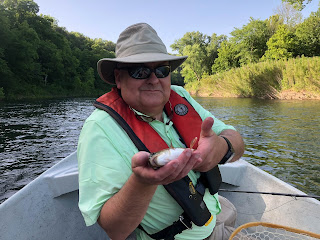In the Ozarks, winter is seldom persistent, so that even the deep winter of late December and early January may be punctuated by warmer, manageable days, and often, a few days in February are almost spring-like. Picturesque, snow covered banks, and problems with ice in the guides are not common here, but certainly beautiful on select occasions. Brisk mornings requiring a jacket are more the rule.
Conditions
It goes without saying that fishing pressure is down during the winter months, but that’s not the only advantage. Moderate days result in lower electricity demand, and along with less rain, can mean greatly diminished generation schedules, providing not just lower flows, but long periods of lower flows that actually allow the trout to adapt to a new river. In my experience, a 3-4 day period of low flow can produce new fishing conditions, as compared to day to day fluctuations in flow. As always, take some time to listen and watch and learn how the river - and the trout - are adapting to these conditions.
Gear
As with any outdoor activity, if you are uncomfortable, you will not have as much fun. So it is important to dress properly, and especially when wade fishing, warm and dry need to be at the top of your list. Good boot socks - I like Browning - will be a good starting point, followed by a layer of insulation beneath your waders of appropriate temperature range. In winter months, I’ve never been too warm under my waders, but you know your own preferences and can dress accordingly. Up top, layering is key, I usually start with a fishing shirt, add a sweat shirt, and finish off with a wading jacket of some sort. Like many of you, I’m trying to break free from decades of a fishing vest, and that usually means a lanyard in warmer weather. In winter, a wading jacket, featuring lots of pockets, provides an alternative to the traditional vest.
While I believe in a hat - I favor a Tilley - on colder days I generally trade it in for a skull cap. My favorite is a Columbia model that has “space blanket” material on the inside to reflect heat back onto my head. Cold head and ears are a bad combination, so make sure you find a good solution to stay warm. Lots of heat can exit your body through your head, especially if your hair has already left, as is my case.
Glasses are important, and you may want a selection of lenses to help with both bright and cloudy days. In the unlikely event there is snow on the ground, you may even need mirrored glasses to cope with the glare. I also strongly prefer sunglasses with “reader inserts” that allow me to see well when working with flies and knots. Recently I’ve been wearing the shooting glasses from SST with interchangeable lenses.
Finally, consider gloves. I prefer fingerless gloves, wool or neoprene have both worked well, to keep the bulk of your hands warm and reasonably dry, while allowing your fingertips to help with detail work of handling flies and tying knots. My favorite trick is to bring along a small towel - golf towels are great because they can generally be clipped on - with which to wipe your hands every time they get wet.
Fly Selection
At least in the White River system, I find that a handful of flies work consistently well, and I don’t find much reason to experiment. For winter fishing, I rely on Sow Bugs, Prince Nymphs, and Hare’s Ear Nymphs, drifted. I will also use Woolly Buggers, especially larger black ones for night fishing. During the day, medium size Olive Drab works great (again, for me, this is my go-to fly year around) I simply drift them and strip back. As you move into February, the likelihood that a warm afternoon will produce a hatch increases, so make sure you have a selection of smaller dry flies in the event the opportunity arises. Blue wing olives (18-22), parachute Adams (16-20) and Elk Hair Caddis (16-18) are all good choices, but don’t hesitate to try something else (or the ever present “this is what I had in my fly box”) as this is how we learn.
Safety
Wading lower water levels still requires care. The unstable rock, occasional deep hole, or extra slippery bottom all call for vigilance. I’ve begun to consistently use a wading staff (found a nice collapsible one at Bass Pro) and just in general paying more attention to my footing. While the water temps don’t vary much, air temperature will, and hypothermia is a real issue if you get soaked. Make sure you have a change of clothes, and a way of getting warm, whether in camp or in your vehicle. If you fish from a boat, don’t neglect good flotation devices - by that I mean actually wear them - as the threat from swift current is ever present, and the cold adds another element of concern. Common sense and a little e
xtra care will go a long way to ensuring that your experiences are memorable only in a fishing sense, not a medical attention sense!
So, at the risk of increasing the population on the river, I will encourage you to plan a winter outing this year. I’m confident you will enjoy learning about your favorite spot at a different time of year. You might even catch a fish! Let me know how you fare!





